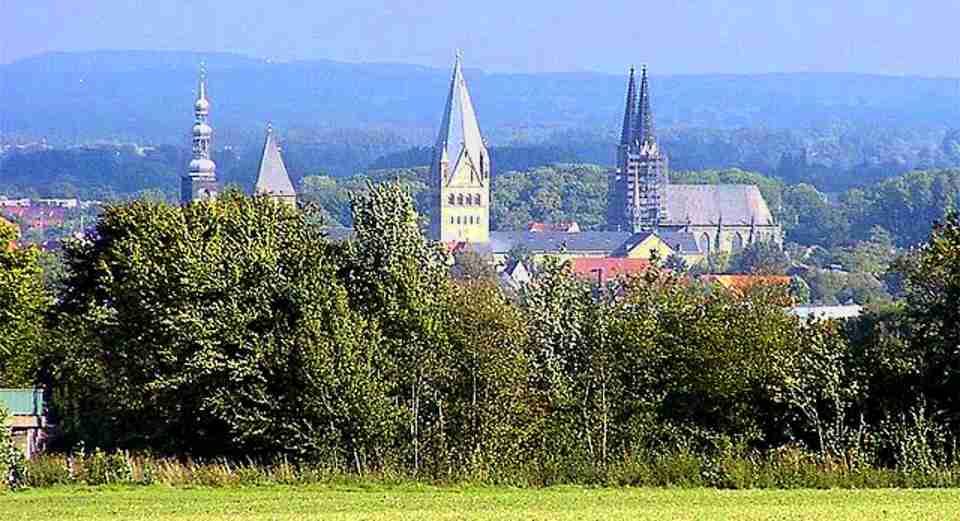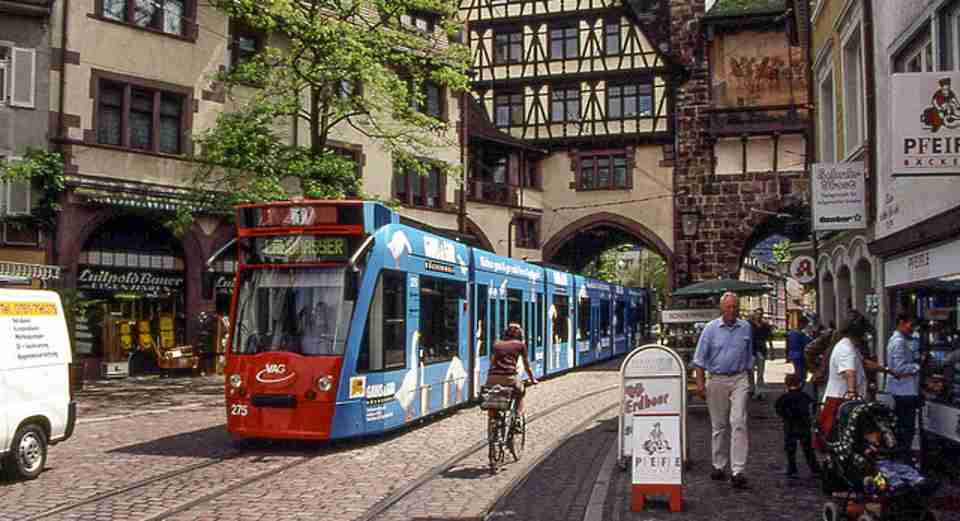Ideal destinations for a weekend trip for explorers, romantics and culture vultures: visit one of the 10 most beautiful towns in Germany!
Especially now that it is finally getting warmer, many Germans are tempted to get away for the weekend and take a short trip out of their familiar surroundings. Somewhere beautiful and new to discover.
Anyone who loves culture and history and cities with flair is in luck when they stroll through the picturesque streets and alleys of a well-preserved historic old town. Despite the war damage, Germany is rich in magnificent buildings from all eras and, especially in smaller towns, the historic town centre is often wonderfully preserved or reconstructed.
Idyllic old towns are also a real tip for romantic weekends with your new love or long-term partner. In the following, we present what we consider to be the 10 most beautiful towns in Germany, sorted north to south.
The 10 Most Beautiful Towns in Germany
1. Lübeck

The northern German Hanseatic city enchants not only fans of Thomas Mann and marzipan. Surrounded by several branches of the river Trave, the city, founded in the 12th century, shows itself to be a real historical jewel of the north.
Here stands the famous late Gothic Holsten Gate, the city’s landmark and one of Germany’s most famous buildings. Some readers will remember: it was on the back of the 50 DM note until 1991, appeared on postage stamps, chocolate biscuits and most recently in 2006 on a series of German 2 euro coins.
But Lübeck’s old town has much more to offer: the old town hall, the castle gate, St. Mary’s Church, Lübeck Cathedral and old gabled houses in the typical North German style of Brickstone Gothic. Lübeck’s historic core is so beautifully preserved that it was declared a UNESCO World Heritage Site in its entirety as early as 1987.
2. Wismar

Just a little further east of Lübeck lies Wismar, the second late medieval pearl on Germany’s Baltic coast to be declared a World Heritage Site. Gothic brick churches and the quaint old harbour with its water gate give Wismar a special atmosphere. In the silent movie classic Nosferatu (1922), Dracula himself wreaks havoc here! Wismar also has one of the largest marketplaces in the country and one of the most idyllic Baltic harbours.
3. Celle

South of the Lüneburg Heath lies one of Lower Saxony’s most beautiful towns: Celle. Around 480 lovingly maintained half-timbered houses in the old town of Celle form the largest contiguous half-timbered ensemble in Europe. The most beautiful building and highlight of every city tour is the Hoppener Haus from 1532.
If you like to go exploring, you can find inscriptions and carvings on many of the old houses during a walk through the old town, which provide information about the occupation and status of the former inhabitants. A cosy place to relax afterwards can be found in the very beautiful French Garden in the south of the old town.
4. Quedlinburg

While the half-timbered houses in Celle form a single unit, they are scattered all over Quedlinburg. On the other hand, there are almost 3 times as many half-timbered houses here, about 1,200! The small town in the Saxony-Anhalt part of the Harz region has been listed as a UNESCO World Heritage Site since 1994, making it one of the largest area monuments in Germany.
Buildings particularly worth seeing include the Zur Rose guildhall, the old stock exchange, the Romanesque monastery church of St. Marien and the imposing Quedlinburg Castle Mill.
5. Soest

While Soest (pronounced Soost, not Söst) is relatively unknown even among Germans today, in the Middle Ages the town was the second largest in the country and Germany’s most important trading centre after Cologne.
Many buildings from medieval times still bear witness to this past glory, such as the Burghof, an old patrician house from 1180, the Pilgrimhaus inn, St. Patrokli’s Cathedral and 7 other medieval churches. Part of the inner rampart of the old city wall has also been preserved, and you can still walk along it today. There is also a lot of architecture from later periods that is worth seeing, such as half-timbered houses and the baroque town hall. Almost the entire city centre (over 600 buildings) is a listed building.
6. Bamberg

The Upper Franconian residential town of Bamberg not only offers one of the truly most beautiful old towns in Germany, but also the largest historic urban area in the republic in terms of surface area. Even in a European comparison, Bamberg stands out as a special feature: nowhere else has the early medieval town structure been preserved as intact as here.
Bamberg owes its architectural splendour above all to the fact that it was the seat of a bishop from 1007 to 1802. As a result, for 8 centuries numerous magnificent buildings and monuments were built in the respective taste of the time and you can literally spend days discovering all the treasures of the city. You definitely shouldn’t miss the Bamberger Dom and the Alte Rathaus, picturesquely situated on an island in the Regnitz! By the way, Franconian Rome is also one of the cities with the highest density of breweries in the world – so after sightseeing you can relax with regional beers in a rustic atmosphere.
7. Trier

Augusta Treverorum, now called Trier, is one of the handful of cities that claim the title of Germany’s oldest city. The fact is that Trier is very old: it was founded by the Romans over 2,000 years ago, making it one of the few cities in the country whose origins lie in antiquity.
Fortunately, some buildings have also survived from Roman times, probably most famously the Porta Nigra, the black gate, which was built around 180 AD and is now Trier’s landmark. The Basilica of Constantine, the Roman Bridge and the ruins of thermal baths as well as an amphitheatre are also still preserved.
But Trier was also a wealthy and influential city in the Middle Ages. The Main Market Square, the Three Kings’ House, the Church of Our Lady and the old Jewish quarter, among others, date from this era. Beautifully situated in the lovely Moselle valley, Trier is one of Germany’s must-see tourist destinations.
8. Rothenburg ob der Tauber

If there is one German town that is internationally famous for its old town, it is Rothenburg ob der Tauber in Middle Franconia. Whether in Japan, China, the USA or Brazil – Rothenburg is almost as well known abroad as Berlin, Hamburg or Munich. The reason: over 2 million tourists visit the small town with just 11,000 inhabitants every year.
As someone who has lived there for several years, I can say: rightly so. Because the entire old town can still be admired in the style of the late Middle Ages, even though part of the town had to be reconstructed after World War II. In addition to numerous beautiful half-timbered houses, highlights include the Jakobskirche church with an impressive carved altar by Tilman Riemenschneider, the many towers and town gates and the Renaissance town hall on the market square. But actually, it’s beautiful everywhere inside the city wall, which you can also walk on. By the way, the best view of the city is from the Burggarten.
9. Heidelberg

Like Rothenburg, Heidelberg should not be missing from any list of Germany’s most beautiful old towns! The ruins of the world-famous Heidelberg Castle from the Renaissance period, the city’s landmark, tower above the idyllic old town on the Neckar. Even the poet Hölderlin sang the praises of the fateful castle, which seemed to him to be torn to the ground by the weather, and even today its sight inspires tourists from all over the world.
But that is by no means all that Heidelberg has to offer. The Old Bridge, first mentioned in 1248 and thus one of the oldest bridges in the country, spans the Neckar. Heidelberg is also the oldest university town in Germany and numerous historic university buildings from different eras are part of the cityscape. Among them is the university library, which houses the Codex Manesse, the most comprehensive manuscript of songs from the German Middle Ages.
Several other squares, churches, museums and historic buildings make Heidelberg one of the most beautiful destinations for a romantic weekend trip.
10. Freiburg

Also one of the most beautiful university cities in Germany is Freiburg im Breisgau. In addition, Freiburg is the German city with the most hours of sunshine per year! If that’s not enough of a reason to spend a weekend here, there’s the wonderful old town with its cathedral.
Here you can see numerous impressive buildings from different eras, such as two medieval city gates, the historic department stores’ from 1532, the Old Guardhouse and the neo-Gothic Colombischlössle. Incidentally, a magnificent late-Gothic town house, the Haus zum Walfisch, served as the model for an eerie ballet school in the classic horror film Suspiria.
For us, these are the 10 most beautiful towns in Germany, but there are of course many more beautiful towns in Germany, no question about it! We love to discover new things, whether cities or leisure activities. That’s why on Greatime you’ll find numerous excursion tips, but also all kinds of others for activities with friends, activities for two or with the family.
Want to stay up to date with our latest tips and ideas? Then follow us on Facebook and Instagram and subscribe to our newsletter 😉
Image source Cover image: Bamberg town hall by magnetism under CC BY 2.0, edited by Greatime
Note: There are affiliate links in this article. This means that if you buy a product, Greatime may receive a small commission.


![Escape Game [Uber En="In*search*of*Grandma*Uschi's*heritage*in*the*Escape*Room*Würzburg*at*Exitrooms*Würzburg" De="Auf*der*Suche*nach*Oma*Uschis*Erbe*im*Escape*Room*Würzburg*bei*Exitrooms*Würzburg"]](https://greatime.de/wp-content/uploads/2018/04/oma-uschis-erbe-exitrooms-wuerzburg-escape-game-erlebnistest.jpg)
![Uber En Quot A Group Of Young People In A Rafting Boat Navigate A Rapids Quot De Quot Eine Gruppe Junger Menschen In Einem Rafting Boot Bef Hrt Eine Stromschnelle Quot [Uber En="When*Isar*rafting*with*friends,*you*also*ride*rapids" De="Beim*Rafting*mit*Freunden*befährt*man*auch*Stromschnellen"]](https://greatime.de/wp-content/uploads/2016/08/rafting-auf-der-isar.jpg)
